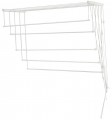Installation
—
Floor. These dryers come with their own stands, allowing them to be placed directly on the floor, as the name suggests. The design of these devices varies—some resemble tables or ironing boards, while others resemble ladders, etc. Despite their relatively large weight, floor models are easy to install — simply unfold the dryer into its working position and place it on a flat surface. However, this option is less suitable for confined spaces with limited floor space. Almost invariably, floor dryers feature a folding design (refer below).
—
Wall. This dryer type requires attachment to the wall using screws, nails, or similar devices. Usually featuring a sliding design (see below), these dryers are more compact than their floor-standing counterparts and can be utilized in spaces with limited floor area, such as balconies. However, the drawback of this option lies in the installation complexity and its unsuitability for mobility, as wall dryers are typically designed for permanent use in a fixed location.
—
Suspended. Similar to wall dryers (see above), these dryers are positioned at a specific height above the ground, eliminating floor space usage. A distinctive feature is their built-in mounts, often in the form of hooks. These mounts enable the dryer to be hung on various supports, such as balcony railings, heating radiators, or the edge of a shower c
...abin. Installation and removal take only seconds, allowing for easy relocation, for example, from the edge of the bathtub to the balcony for final air drying. However, the range of suitable locations is somewhat limited, some may not match the mount size, and these mounts are not as secure as wall mounts.
— Ceiling. True to its name, this dryer type is intended for ceiling mounting, often using liana-type structures (see below). Ceiling models share similar advantages and disadvantages with the wall-mounted ones described earlier, but in this case, both aspects are more pronounced. These constructions not only conserve floor space but also elevate items for drying to a greater height. However, their installation is considerably complex both procedurally and due to heightened reliability requirements.
— Wall/ceiling. Dryers equipped with universal mounts that allow you to install them both on the wall and on the ceiling, as desired. Features of both installation options are described above; here we note that in general, in terms of design, these models are closer to the ceiling ones, since the “liana” option is most often used.
— Over the bath. Many of these models feature an inverted V-shaped design, providing a practical function for drying delicate items that cannot be spun. This design allows water to drain directly into the bath, making it convenient. It's especially beneficial for apartments where the bathroom serves as the ideal space for drying clothes.
It's worth noting that, in theory, hanging dryers can also be affixed to the bath (refer to "Type"); however, the practical feasibility varies significantly depending on the features of each specific model. Therefore, the full possibility of installation on a bath cannot be universally asserted in this case, and this function is not specified in the characteristics of hanging dryers.
— Street (outdoor). Outdoor dryers, by nature, feature a robust design incorporating materials resistant to moisture, UV radiation, and temperature extremes. Additionally, their expansive working surface (refer below) is a notable characteristic. Numerous models are specifically designed for direct installation into the ground, making them suitable for private courtyards, summer cottages, and similar settings. Wall-mounted options are also available, typically in a more compact size.Total working surface
Under the total working surface is meant the total length of all drying rods in the expanded state. The
longer this length, the more laundry can be placed on the dryer and, usually, its maximum load is higher (see below). At the same time, this parameter also affects the dimensions and price of the device.
Max. load
The highest weight of laundry that can be dried (of course, we are talking about wet laundry). In addition to the general weight limit, the detailed specifications can also specify the allowable load on each individual rod.
At home, it is impossible to accurately control compliance with this limitation, but it is still worth taking measures to prevent overload. After all, although many drying racks have a certain margin of safety and can carry a lot of weight without visible consequences, off-design loads on the structure reduce its durability and increase the risk of unexpected breakdown.
Number of rods
The number of individual rods provided for in the design of the drying rack. The more such rods are provided for with the same total working surface, the shorter the length of each of them and the more compact the dimensions of the device in the unfolded state can be. On the other hand, short rods are poorly suited for sheets, blankets and other large items.
Dimensions (unfolded)
General dimensions of the drying rack in working position, taking into account all additional elements — side wings (see above), retractable parts (see "Design"), etc. This parameter will allow you to estimate how much space is required to use a particular model.
Dimensions (folded)
General dimensions of drying rack in the folded position. The smaller they are, the more convenient this model is in storage and transportation.
Length
An indicator that determines the length of the working surface for wall-mounted and ceiling-mounted drying racks, as well as the length of one largest section without “wings” for floor-type models. Allows you to select lines of different lengths from one model range of drying racks.

